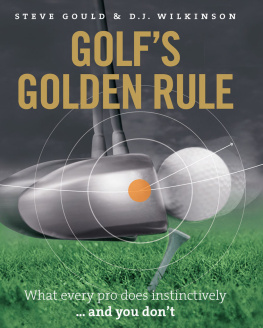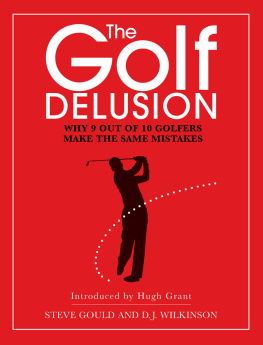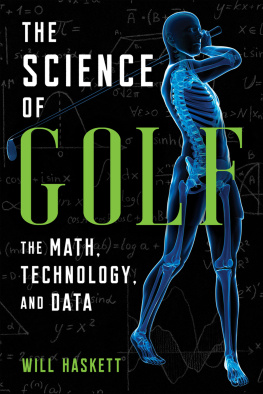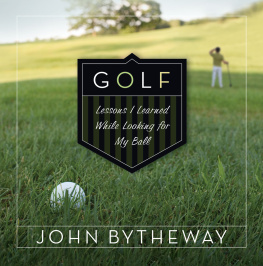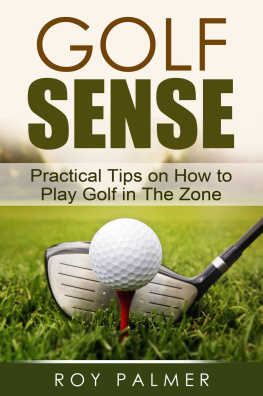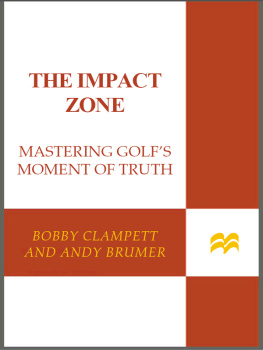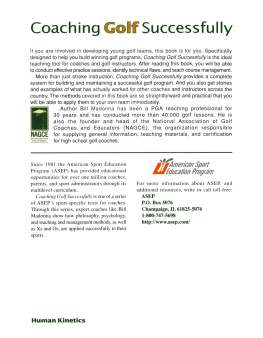
USEFUL EQUIPMENT FOR THIS BOOK
There are Best Practice sections throughout this book containing exercises that you can do to improve and maintain your swing. You may also wish to follow some or all of the other routines we describe. In order to be best prepared, you will find the following household items and pieces of standard golfing equipment helpful:
A golf club, preferably an iron as they are easier to swing in an average home.
An impact bag, available from all good golf stores and pro shops. You can also improvise with an old holdall.
An empty grip, available from all golf stores and pro shops. Alternatively, your local pro shop may cut down an old club for you. If they do so, ask for a couple of inches of shaft to be left below the grip. In place of either of these, a small-scale childrens club would work.
A frying pan or a tennis racquet!
A full-length mirror.
Please also remember that you can flip this eBook edition into portrait mode, landscape mode and you can magnify the text - whichever suits you best!


WHAT EVERY PRO DOES INSTINCTIVELY AND YOU DONT
Impact should not be left as a blur. Impact is the moment that decides where the ball will go, at what trajectory and at what speed. It is the one moment during your swing when club makes contact with ball.
Next time you go to a professional golf tournament, arrive early and head for the practice range. Watch closely. Youll see something fascinating.
Most of the top players open their warm-up sessions with a ritual so innocuous that it fails to register with onlookers. Selecting a short iron, they peer down the range while making a series of miniature swings. The club is swung back and through, brushing the grass on the way. Its almost as if theyre searching for something.
Go to your local range and youll see something quite different. There, players begin with full swings often with the driver while checking their alignment or looking over their shoulder to admire the top of their backswing. Theres nothing wrong, of course, with big practice swings or with checking your alignment and backswing. Theres logic to it. But its not what the pros do.
So what are they up to?
Simply put, theyre reacquainting themselves with impact and the impact zone.
Its obvious, once you give it some thought. The impact zone an area measuring a couple of feet before the ball and a couple after it is what good golf is all about. Its sometimes referred to as the business end of the golf swing. As such, it should be analysed, understood and practised more than anything else.
But it isnt.
Work your way through most golf instruction and youll find that impact barely warrants a mention not in any detailed sense, anyway. Youre told to get your hands ahead of the ball and hit down. Youre told divots are good. And thats about it.
Millions of words have been written on grip, alignment, posture and set-up, on shoulder turn and weight shift. Entire books have been devoted to the power of positive thinking. Clearly, these are important factors. Many, indeed, are fundamental. As golf teachers, we spend a great deal of time building or reshaping our students backswings. That will never change. A structured backswing, downswing and throughswing are all close relations of the impact zone.
But the importance of impact seems to have got lost in golfs ever-increasing mountains of detail. As everyone stampedes in search of the sports next Big Idea, impact has been passed by. It has become just another fleeting moment, a millisecond, a blink of an eye, to be squeezed in somewhere between perfect backswings and picture-postcard finishes.
Ask most players at your club what theyre working on and you can guarantee that no one will mention impact.
Impact just happens, doesnt it?
Its an understandable reaction. Impact is a mystery to the majority of golfers, even very good players. Good players rely on instinct. Few of them are able to explain exactly what their hands and arms do as the club travels at 100 mph through the impact zone. I just hit it, theyll tell you. And that is exactly what they do. They are the lucky, naturally talented few.
For lesser golfers, though, impact gets lost in a red mist of frustration and misplaced optimism.
Until recently, video had not been sophisticated enough to isolate the key moments of impact in single frames, offering instead a blur of hands and club. That made it very hard to dissect what is happening. Many teachers, pressurised by their pupils impatience to get out and play, choose to brush the impact zone under the carpet.
After all, impact just happens, doesnt it?
No.
Impact should not be left as a blur. It is not a moment. It is The Moment. Impact is the moment that decides where the ball will go, at what trajectory and at what speed. It is the one moment during your swing when club makes contact with ball.
Which is why the impact zone represents the heart of this book.
We will, of course, continue into the backswing on the one side, and the finish on the other. For 99 out of 100 golfers, these must be mastered as well. Take the backswing. Only the most mercurial of players can merge an eccentric backswing with a great impact. For the rest of us, a good, solid backswing is a prerequisite for success.
But remember. A pure ball strike is everything. That is what makes impact the moment of truth.
Technically, the golf swing may start with the set-up and end with the finish. For us, though, golf starts and ends with impact.
Impact is everything .

GOLFS GOLDEN RULE
A pure ball strike is everything. That is what makes impact the moment of truth.
IN THE ZONE
If a textbook impact zone forms an integral part of your swing, then youre a good golfer. And if it does not, you probably arent.
Its that simple.
A golf swing without a textbook impact zone is, in 99 out of 100 cases, a golf swing going nowhere or, more accurately, one heading for the long grass.
Some good players, its true, consistently salvage their swings at the last moment and hit straight shots despite not entering the impact zone correctly. They tend to have very fine hand control, with which they subsidise the rest of their swing. And they tend to play and practise a great deal. A very great deal.
The vast majority of golfers, though, will pull off such salvage operations only occasionally. Very occasionally. And dont be fooled when, one time out of 20, you succeed in hitting a 250-yard drive straight down the fairway or strike a 7-iron approach to 5 feet. Were sorry, but that shot does not prove that you can do it. It merely proves that you can do it ONE TIME OUT OF 20. The statistics do not lie. Your bad shots will continue to far outnumber your good.
Get into the correct position coming into impact, however, and the opposite is true. You will be perfectly placed to deliver the club face squarely into the back of the ball.
Theres no way round golfs Golden Rule. A correct impact zone must form part of a good, reliable and repeatable swing.
But heres the good news. Be methodical, take one small step at a time, and its easier to achieve than you may think.
Next page
